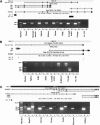Transcription-mediated gene fusion in the human genome
- PMID: 16344562
- PMCID: PMC1356126
- DOI: 10.1101/gr.4137606
Transcription-mediated gene fusion in the human genome
Abstract
Transcription of a gene usually ends at a regulated termination point, preventing the RNA-polymerase from reading through the next gene. However, sporadic reports suggest that chimeric transcripts, formed by transcription of two consecutive genes into one RNA, can occur in human. The splicing and translation of such RNAs can lead to a new, fused protein, having domains from both original proteins. Here, we systematically identified over 200 cases of intergenic splicing in the human genome (involving 421 genes), and experimentally demonstrated that at least half of these fusions exist in human tissues. We showed that unique splicing patterns dominate the functional and regulatory nature of the resulting transcripts, and found intergenic distance bias in fused compared with nonfused genes. We demonstrate that the hundreds of fused genes we identified are only a subset of the actual number of fused genes in human. We describe a novel evolutionary mechanism where transcription-induced chimerism followed by retroposition results in a new, active fused gene. Finally, we provide evidence that transcription-induced chimerism can be a mechanism contributing to the evolution of protein complexes.
Figures




References
-
- Communi, D., Suarez-Huerta, N., Dussossoy, D., Savi, P., and Boeynaems, J.M. 2001. Cotranscription and intergenic splicing of human P2Y11 and SSF1 genes. J. Biol. Chem. 276 16561-16566. - PubMed
-
- Gardiner-Garden, M. and Frommer, M. 1987. CpG islands in vertebrate genomes. J. Mol. Biol. 196 261-282. - PubMed
Web site references
-
- http://www.ncbi.nlm.nih.gov/Genbank/; NCBI GenBank version 136 (June 2003).
-
- http://www.ncbi.nlm.nih.gov/genome/guide/human/; human genome build 33 (April 2003).
-
- http://genome.ucsc.edu/; This site contains the reference sequence and working draft assemblies for a large collection of genomes. It also provides a portal to the ENCODE project.
MeSH terms
LinkOut - more resources
Full Text Sources
Other Literature Sources
